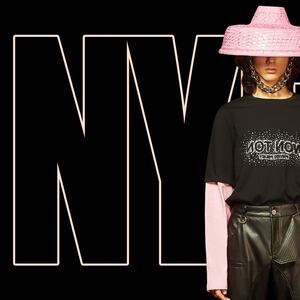One year ago this week, the last “normal” New York Fashion Week just wrapped. For five days, overtired designers showed their collections in front of cramped audiences. Those who scored front row invitations were practically sitting in each other’s laps. There were no masks or travel restrictions; people flew from across the world to be there. The biggest drama of the week seems fairly quaint now: the presentations held that Sunday evening overlapped with the Oscars. Some editors had to choose which star-studded event to cover—the indignity of it all.
Now, of course, the fashion world has been gutted by a pandemic that changed how people shop—and dress—nearly overnight. The Council of Fashion Designers (CFDA) launched a website, Runway360, where shows debut mostly in the form of short films.
There are a few in-person events, like Jason Wu’s pop-up grocery/runway, which had around 25 guests. There are a few showrooms open by appointment, notably one held by the advocacy group Black in Fashion Council. But for the most part, it’s an entirely virtual affair.
And a confusing one. As Booth Moore reported in WWD, “The collection presentations that kick off [this week] may be the most splintered since New York Fashion Week began more than 75 years ago.”
The CFDA and IMG, the management company that owns NYFW: The Shows, have released separate schedules and online platforms to watch the presentations. Oh, and the CFDA announced that it’s actually no longer called New York Fashion Week—it’s American Collections Calendar now, get used to it.
The biggest designers, the ones that even non-fashion people know—such as Ralph Lauren, Marc Jacobs, Michael Kors, and Calvin Klein—have ditched this season and not yet bothered to let anyone in on future plans to return to runways.
Other buzzy names like LaQuan Smith and Jonathan Cohen, who designed one of the coats Jill Biden wore during inauguration week, have decided to claim their own, seemingly random days to drop their collections. Those days span into March and April, but somewhat comically are still included on the CFDA’s “American Collections” calendar. Fashion week has become a few weeks. (The CFDA declined The Daily Beast’s request for comment. Reps for IMG would not speak on the record.)
Tom Ford, chair of the CFDA, was not available for an interview. He addressed the designer mutiny in a CFDA press release... sort of.
“Whatever or however American designers choose to show their collections, it is our job as the CFDA to honor our original mission statement and help promote and support American fashion,” he said. “Therefore, we will publish on the schedule not only the schedule of designers showing in New York during New York Fashion Week but also those of American designers showing off calendar and abroad.”
Tom Ford would have showed digitally this week, but as he told New York Times fashion critic Vanessa Friedman over Instagram Live, a COVID outbreak shut down his Los Angeles atelier. Hopefully, he said, the collection will be revealed next week.
Ford added that he wants to show this September, when, tentatively, he believes in-person events will return.
While the calendar switch-up at NYFW may be dramatic, it is somewhat indicative of what’s going on in style capitals around the world. The British Fashion Council, which governs London Fashion Week, announced in October that it would merge its menswear collections into its womenswear shows, in an attempt to both streamline the schedule and ease the binary restrictions of gendered dressing. It will kick off on February 19 and run until the 23.
But Victoria Beckham debuted her fall collection on Valentine’s Day, eschewing her tradition of showing at LFW.
Immediately after London comes Milan, which runs from February 23 to March 1. The Business of Fashion reports that, of course, it will be mostly digital. Versace will not present, which is somewhat surprising and a drag for anyone in need of another viral J.Lo dress moment. Christian Siriano, an American designer, will hold his show on February 25, though he is technically on the American Collections Calendar.
Then it’s on to Paris, where heavyweights like Balenciaga and Maison Margiela chose to show outside of the calendar. Gabriela Hearst, who was on the Paris schedule last season, crossed the pond to present on the New York bill this month. Somehow, this all makes sense.
The CFDA, plus Anna Wintour and Vogue, began the fund “A Common Thread,” which has raised $5 million in aid to struggling designers. But the whole “We support you” narrative pushed by the CFDA and Tom Ford has left many wondering if much of the talk from the organization is just that—talk.
As Ulla Johnson, known for her airy boho dresses, told WWD, “It feels like we’re on islands of our own.”
So designers are left to fend for themselves, and everyone else in the industry wonders what pandemic-induced changes will stick in a post-vaccination world. Will the American Collections Calendar still make room for those showing abroad or off schedule once in-person events return? This could lead to an even more frantic schedule, with extra globe-trotting during a week that’s supposed to be held in just one city.
“Looking into the future, as live shows return, and as the calendar becomes more dispersed and scattered, I do think there may be even more negative implications for sustainability,” Samantha Haran, a fashion and culture writer, told The Daily Beast. “International models, editors, stylists, and other staff are going to be flying out to New York more than once for a single season, and fashion’s contribution to travel is already one of its biggest contributions to global pollution.”
But Tyler McCall, the editor-in-chief of Fashionista, noted to The Daily Beast that plenty of designers had ditched the CFDA’s schedule before the pandemic, too. Last February, Ralph Lauren, Tommy Hilfiger, Jeremy Scott, Phillip Lim, and Tanya Taylor skipped out on the event, back when the coronavirus didn’t feel like a threat and was just a reason to stock up on hand sanitizer.
“It’s been harder and harder to keep designers on the traditional NYFW schedule for so many reasons: it’s overcrowded, there’s been a decline in travel from overseas editors, it’s become more about influencers and creating the biggest spectacle, in a way that isn’t sustainable for many designers,” McCall said. “Switching over to the American Collections Calendar is a way for the CFDA to make things look like they are still at least somewhat unified, in my opinion.”
McCall believes that many designers will return to the “proper schedule when things are closer to normal again.” Until then, it makes sense for them to speak directly to the specific audience they feel are customers. “Thom Browne presenting in Paris is a way for him to set his work up alongside those more couture-minded fashion brands,” she said. (A rep for Thom Browne did not respond to The Daily Beast’s request for comment.)
The question remains: who is fashion week serving right now? Certainly not the public, as very few digital shows have made a cultural impact. (Haran noted one exception: the Valentino haute show streamed from Rome last July, where models wore elongated dresses and appeared to be floating in space.)
This fashion week is certainly a noisy one, with plenty of distractions and an overall fractured feeling. Of course, clothing is still important, and plenty of emerging designers have proved that New York is still an industry capital. But overall, this season’s kerfuffle points to an existential crisis at NYFW. “We are in a significant socio-political and cultural moment right now,” Haran said. “[Considering that], the spectacle of fashion week seems very insensitive.”


